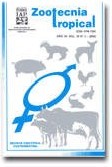
|
Zootecnia Tropical
Instituto Nacional de Investigaciones Agrícolas Venezuela
ISSN: 0798-7269
Vol. 20, No. 2, 2002, pp. 191-203
|
 Bioline Code: zt02012
Bioline Code: zt02012
Full paper language: Spanish
Document type: Research Article
Document available free of charge
|
|
|
Zootecnia Tropical, Vol. 20, No. 2, 2002, pp. 191-203
| es |
Efecto de la edad del rebrote y tasa de crecimiento del mataratón ( Gliricidia sepium  ) sobre su bromatología y minerales ) sobre su bromatología y minerales
César Araque, Guillermo Arrieta, Alexander Sánchez y Espartaco Sandova
Resumen
Para determinar el valor nutricional y tasa de crecimiento del mataratón ( Gliricidia sepium

) como recurso alimentario en ganadería bovina doble propósito, se realizó un ensayo en el área de Tres Islas, Municipio García de Hevia, estado Táchira. Se seleccionaron 40 plantas que servían de estantillos para una cerca viva de un potrero, las cuales se podaron a ras de la parte superior de los estantillos (1,80 m aproximadamente). Posteriormente fueron sometidas a un diseño de bloques al azar, con tres repeticiones, donde eran tomadas 3 muestras compuestas cada 30 días, durante un año, para determinar: materia seca, grasa, cenizas, proteína cruda y algunos minerales. Previo a ello, las ramas fueron medidas desde el ápice hasta donde ellas emergían a fin de determinar la tasa de crecimiento. Los resultados indican que a medida que transcurría el tiempo, la planta aumentó (P<0,05) el contenido de materia seca, grasa, Ca, Mg y Mn, desde 10,33 a 13,79%, 1,88 a 4,12%, 0,19 a 1,39%, 0,20 a 0,40% y 16,3 a 62%, respectivamente. Los valores de proteína cruda, cenizas, P, K, Fe y Zn disminuyeron significativamente con valores comprendidos entre 26,52 a 21,60%, 11,06 a 6,03%, 0,49 a 0,15%, 3,20 a 0,91%, 263,60 a 152,00 ppm y 59,30 a 31,04 ppm, respectivamente. Finalmente, la tasa de crecimiento mensual presentó un promedio de 39,83 cm. Estos resultados indican que el mataratón además de poseer un alto valor nutricional, posee un crecimiento rápido y vigoroso para las condiciones de la zona en estudio.
Mataratón, valor nutricional, tasa de crecimiento, cercas vivas, bovinos
|
| |
| en |
Effect of regrowth age and growing rate of mataraton ( Gliricidia sepium  ) on it's bromatology and minerals ) on it's bromatology and minerals
César Araque, Guillermo Arrieta, Alexander Sánchez y Espartaco Sandova
Abstract
To determine the nutritional value and growth rate of mataraton ( Gliricidia sepium

) as feedstuff for dual purpose cattle, a trial was carried out in the area of Tres Islas, Garcia de Hevia county, Tachira state, Venezuela, characterized by a mean temperature of 26.9 °C, average annual rainfall 2,651 mm, at an altitude of 127 mase and the climate is classified as tropical humid forest type ( bh-T ). A total of 40 plants that were usep as a paddock living fence, were trimmed every 30 days at the trunk top level, where 3 compound samples were monthly taken random y for a year, to determine dry matter, lipid, ash and, protein content and some minerals. Before that, branches were measured from their tips to the base determine its growth rate. Results showed that, plant maturation level increased (P<0.05) the content of dry matter and lipids from 10.33 to 13.79%, and 1.88 to 4.12%, respectively. Meanwhile protein and ashes content decreased (P<0.05) from 26.52 to 21.60%, and 11.06 to 6.03%, respectively. Regarving to mineral content, P, K, Fe, and Zn decreased (P<0.05) from 0.49 to 0.15%, 3.20 to 0.91%, 263.60 to 152.00 ppm, and 59.30 to 31.04 ppm, respectively. Ca, Mg and Mn values increased from 0.19 to 1.39%, 0.20 to 0.40% and 16.3 to 62.0%, respectively. Finally, monthly growth rate showed a mean of 39.83 cm. These results showed that besides its high nutritional value, mataraton has a vigorous and fast growing pattern.
Mataraton, regrowth, nutritional value, growth rate, living fences
|
| |
© Copyright 2002 - Zootecnia Tropical. Free full-text also available online at http://www.ceniap.gov.ve/bdigital/ztzoo/ztindice.htm
Alternative site location: http://www.sian.inia.gob.ve/repositorio/revistas_ci/ZootecniaTropical/ztindice.htm
|
|
